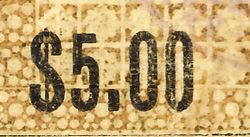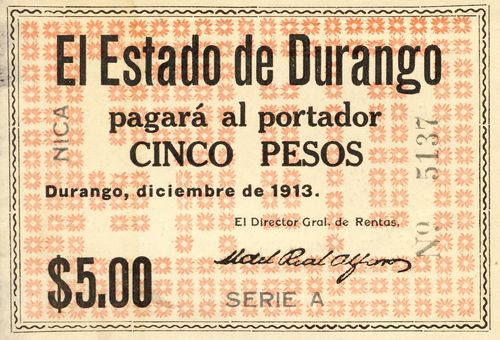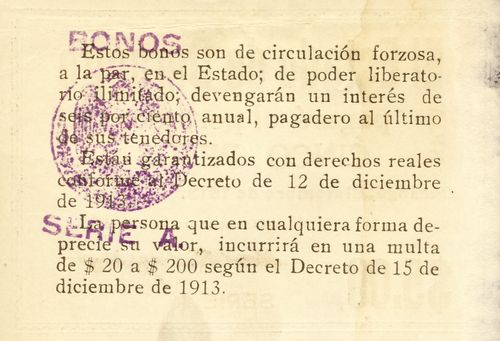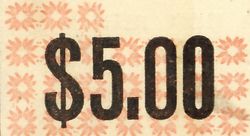Counterfeit Estado de Durango notes
50c, $1 and $5 Estado de Durango notes were counterfeited.
On 26 June 1914 F. Rios Laurenzana asked the jefe político of Ciudad Lerdo and presidente municipal of Torreón to investigate the origin of some false $5 notes which he presumed came from a printshop in TorreónADUR, Libro Copiador 279, Hacienda 25 April 1914 - 27 July 1914, p286 and p287.
In February 1915, because of the large number of counterfeit 50c Series A notes in circulation, the government decided to review the notes in the Dirección General de Rentas and perforate and overstamp the bogus onesLa Voz de la Revolución, Tomo 1, Núm. 38, 5 February 1915.
On 6 February, in a reply to Luis Orozco, the jefe político interino of Mezquital, Gaxiola said that the yellow $1 and $5 bonos had been counterfeited on a grand scale. The counterfeits were easy to recognize because of the roughness of the printing, particularly of Alfaro’s signature, which in the genuine was of delicate characters and features, while in the false the impression was dirty and the features and characters very rough (por lo tozco de la impresión, particularmente la firma de Alfaro que en los buenos es de caracteres y rasgos delicados, mientras en los falsos la impresión es sucia y los rasgos y caracteres muy toscos)ADUR, Fondo Secretaría General de Gobierno, Sección Siglo XIX, Serie Correspondencia, Subserie Revolución, gaveta 6, nombre 88.
By 27 April Jesús Hernández had fulfilled his commission to inform the Comandante Militar of Torreón how to distingush the counterfeit December 1913 notesADUR, Fondo Secretaría General de Gobierno, Sección Siglo XIX, Serie Correspondencia, Subserie Revolución, gaveta 6, nombre 88.
On 7 May Gaxiola sent the jefe político of San Dímas a note containing instructions to recognise false December 1913 notesADUR, Libro Copiador 298, Hacienda 23 February 1915 - 26 May 1915, p405.
According to one notice bogus $1 notes were almost always ‘aged’ to hide their weak colours, and some were copies on India paper, touched up in pencil and with paper stuck on the back. The bogus $5 notes were notably larger, the printing cruder, the lithographed signature of del Real Alfaro was poorer but most obvious was that the ‘$5’ in the lower left corner was thicker and larger. Finally the deep pink background was poorly imitated. Both denominations lacked the embossed seal and the rubber stamp on the back was badly done. Another notice highlighted the different endings of Alfaro’s signatureADUR, Fondo Secretaría General de Gobierno, Sección Siglo XIX, Serie Correspondencia, Subserie Revolución, gaveta 6, nombre 88.
To summarise the characteristics were:
counterfeit 50c Estado de Durango
| GENUINE | COUNTERFEIT |
counterfeit $1 Estado de Durango
| GENUINE | COUNTERFEIT |
 Signature dirty and very rough (sucia y los rasgos y caracteres muy toscos) Signature dirty and very rough (sucia y los rasgos y caracteres muy toscos) |
|
| almost always ‘aged’ to hide their weak colours | |
| some on India paper, touched up in pencil and with paper stuck on the back | |
| embossed seal missing | |
| rubber stamp on the back badly done |
counterfeit $5 Estado de Durango
| GENUINE | COUNTERFEIT |
| notably larger | |
| printing cruder | |
| deep pink background poorly imitated | |
 Signature dirty and very rough (sucia y los rasgos y caracteres muy toscos) Signature dirty and very rough (sucia y los rasgos y caracteres muy toscos) |
|
|
signature ends with point thus:
|
|
 |
$5’ in the lower left corner thicker and larger |
| embossed seal missing | |
| rubber stamp on the back badly done |


| Series | from | to | total number |
total value |
code |
||
| $5 | A | NICA | vertical includes numbers 4635 to 5137 |
||||
| VSNRZ | vertical includes numbers 2193CNBanxico #10888 to 2710CNBanxico #3943 |


